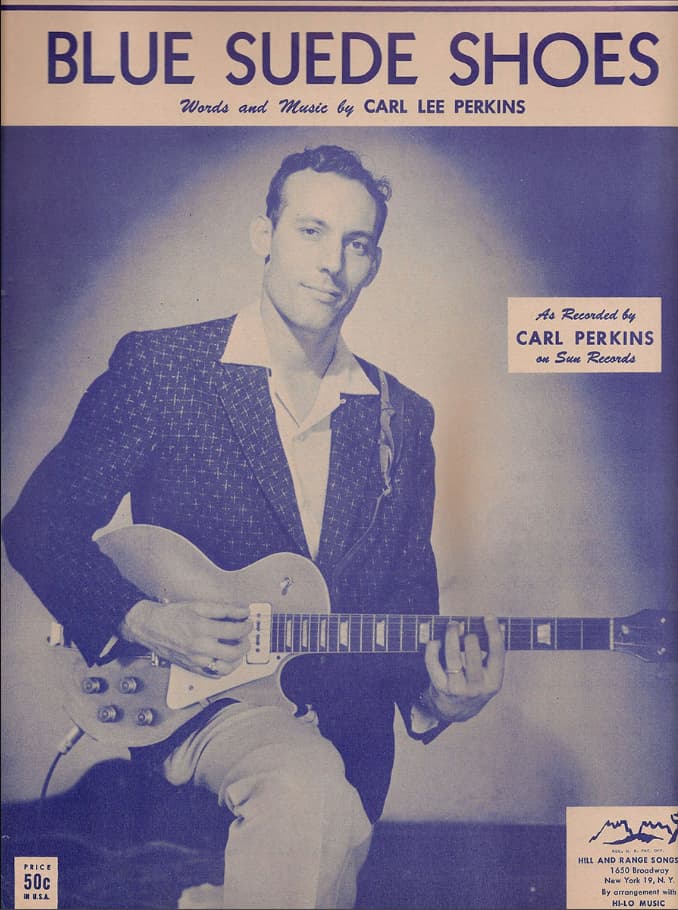
Carl Perkins’ “Blue Suede Shoes” – A Rockabilly Revolution
When Carl Perkins released “Blue Suede Shoes” in early 1956, the world of music was forever changed. This rock and roll standard, written and first recorded by Perkins himself in 1955, quickly became a cornerstone of the emerging rockabilly genre, blending elements of blues, country, and pop music of the time. Its journey to the top of the charts is a testament to its enduring appeal and significant impact on popular music.
“Blue Suede Shoes” is often hailed as one of the first rockabilly records, a genre that fuses the raw energy of rock and roll with the twang of country music. Perkins’ distinctive guitar playing and catchy lyrics captured the spirit of a generation eager for something new and exciting. The song’s rapid rise in popularity was nothing short of meteoric. Upon its release, it quickly made its way onto the Cashbox Best Selling Singles list, where it remained for 16 weeks, peaking at the number two position for two weeks.
The initial release of “Blue Suede Shoes” faced a minor hiccup when two copies sent to Perkins on 78-rpm records arrived broken. However, this small setback didn’t deter the song’s success. In Cleveland, Ohio, disc jockey Bill Randle played the song frequently on his nightly show, prompting a massive demand that saw an additional 25,000 copies shipped to the city. Even in Perkins’ hometown of Memphis and Jackson, the song’s B-side, “Honey Don’t,” initially overshadowed it on the radio, but “Blue Suede Shoes” soon took the lead.
By February 11, 1956, “Blue Suede Shoes” had climbed to the number two spot on the Memphis charts, and by the following week, it had secured the number one position, holding it for the next three months. This success wasn’t limited to regional charts; by March 17, Perkins became the first country artist to reach the number three spot on the rhythm and blues charts. The song’s appeal transcended genres and demographics, garnering a diverse audience.
Perkins’ live performances also contributed to the song’s success. He made multiple appearances on the radio program Big D Jamboree in Dallas, where he played to sold-out crowds. Music shops in Dallas ordered the record in large quantities, with shipments reaching up to 20,000 copies per day at one point. On March 17, Perkins and his band performed “Blue Suede Shoes” on ABC-TV’s Ozark Jubilee, further cementing its popularity.
Tragically, Perkins’ rise to stardom was interrupted by a serious car accident on March 22, 1956, just two days before he was scheduled to appear on The Perry Como Show. While Perkins recuperated in the hospital, “Blue Suede Shoes” continued its ascent, reaching number one on most pop, R&B, and country regional charts. The song also held the number two position on the Billboard Hot 100 and country charts, trailing only Elvis Presley’s “Heartbreak Hotel.”
Despite his setbacks, Perkins’ influence on rock and roll is undeniable. He paved the way for future artists and left an indelible mark on the music industry. By mid-April, “Blue Suede Shoes” had sold over one million copies, earning Perkins a gold record and making it the first million-selling country song to cross over to both the rhythm and blues and pop charts.
Although Elvis Presley‘s version of “Blue Suede Shoes” overshadowed Perkins’ original in the long run, Perkins’ contribution to the genre cannot be overstated. He remained a respected figure in the music world, with his songwriting talents recognized and celebrated. In 2003, Paul McCartney’s company, MPL Communications, purchased the rights to “Blue Suede Shoes” and other Perkins’ songs, ensuring that his legacy would endure.
“Blue Suede Shoes” remains a classic, a song that not only defined an era but also helped shape the future of rock and roll. Its timeless appeal and historical significance continue to resonate with music lovers around the world.